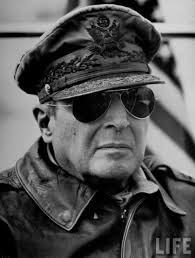Ray-Ban is an American brand of sunglasses founded in 1937 by Bausch & Lomb. They were introduced for the United States Army Air Corps. In 1999, Bausch & Lomb sold the brand to the Italian Luxottica Group for a reported $640 million.
Ray-Bans were first created in 1936. Some years earlier,
Lieutenant John A. Macready (an American test pilot) returned from a balloon
flight, complained that the sun had permanently damaged his eyes, and contacted
Bausch & Lomb asking them to create sunglasses that would provide
protection and also look sophisticated. On May 7, 1937, Bausch & Lomb took
out the patent, and the Aviator was made available to the public. The
prototype, known as Anti-Glare, had a frame weighing 150 grams . They were made
of gold-plated metal with green lenses made of mineral glass to filter out
infrared and ultraviolet rays. Pilots in the United States Army Air Corps
immediately adopted the sunglasses. The army wanted sunglasses that would
protect the soldiers' eyes from harmful light while maintaining a stylish look.
The Ray-Ban Aviator became a well-known style of sunglasses when General
Douglas MacArthur landed on the beach in the Philippines in World War II, and
photographers snapped several pictures of him wearing them. Ray-Bans were
quickly seen outside the army. They quickly gained popularity through other
wars and even made a debut in the movies In 1952, Ray-Ban created another
style, the Ray-Ban Wayfarer, this time with plastic frames, which became
popular soon after its release. By 1962, Ray-Ban started to create
impact-resistant lenses. It was not until ten years later when the United
States of America made impact-resistant eye wear mandatory through the FDA
regulation. Wayfarer sunglasses were seen on movie stars, TV stars, and
musicians. Ray-Ban still remains a top designer in the sunglasses industry with
its constant changes of color, frames, and lenses.
Aviator sunglasses are a style of sunglasses that were developed by Bausch & Lomb and branded as Ray-Ban. They are characterised by dark, often reflective lenses having an area two or three times the area of the eyeball, and very thin metal frames with double or triple bridge and bayonet earpieces or flexible cable temples that hook behind the ears. The original design featured G-15 tempered glass lenses, i.e., neutral gray, transmitting 20% of incoming light. The large lenses are not flat but slightly convex. The design attempts to cover the entire range of the human eye and prevent as much light as possible from entering the eye from any angle.
Aviator sunglasses, or "pilot's glasses", were
originally developed in 1936 by Ray-Ban for pilots to protect their eyes while
flying. Aviators were given their name due to their original intention of
protecting aviator's eyes. Ray-Ban began selling the glasses to the public a
year after they were developed.
The Aviator became a well-known style of sunglasses when
General Douglas MacArthur landed on the beach in the Philippines in World War
II. Newspaper photographers snapped several pictures of him wearing them. The
style was also issued to and found popularity with the French Army.
Aviator sunglasses became fashionable in the 1960s, but
their popularity would increase following pop culture references by Paul
McCartney,[3] Ringo Starr,[3] Freddie Mercury, and later use by celebrities in
films like Top Gun, where Tom Cruise, Val Kilmer, and Anthony Edwards sported
them (sales of the brand rose 40% in the 7 months following the release of the
film).
Ray-Ban Wayfarer sunglasses have been manufactured by
Ray-Ban since 1956, when their design was a revolutionary break from the metal
eyewear of the past. Wayfarers enjoyed early popularity in the 1950s and 1960s.
Though the sunglasses had faded from the limelight by the 1970s, a lucrative
1982 product placement deal brought Wayfarers to their height of popularity.
Since the mid-2000s, the sunglasses have been enjoying a revival.
Wayfarers are sometimes cited as the best-selling design of
sunglasses in history (although Ray-Ban Aviators have also been credited with
this achievement) and have been called a classic of modern design and one of the most enduring fashion icons of
the 20th century.
Wayfarers were designed in 1952 by American optical designer
Raymond Stegeman, who procured dozens of patents for Bausch and Lomb, Ray-Ban's
parent company at that time. The design was a radically new shape, "a
mid-century classic to rival Eames chairs and Cadillac tail fins."
According to design critic Stephen Bayley, the "distinctive trapezoidal
frame spoke a non-verbal language that hinted at unstable dangerousness, but
one nicely tempered by the sturdy arms which, according to the advertising,
gave the frames a 'masculine look.'" Despite this assessment, celebrities
throughout the 1950s and 60s, both male and female, such as Marilyn Monroe, Kim
Novak, Roy Orbison, Bob Dylan and Andy Warhol all famously sported the
sunglasses, some actually donning clone styles of them. John Lennon notably
wore Wayfarers in the mid-1960s, prior to his fondness for teashades. John F.
Kennedy frequently wore Wayfarer-style sunglasses in public.
Ray Ban Wayfarers, which took advantage of new plastic
molding technology, marked the transition between a period of eyewear made from
thin metal frames to an era of plastic eyewear.












.jpg)
.jpeg)



No comments:
Post a Comment